Product discovery is a messy, hard, and often thankless job. Quite frankly, there’s no way — or need — to sugarcoat this. Product discovery is also rarely linear, let alone foreseeable. There’s also no one-size-fits-all approach to doing it “perfectly.” As a result, product teams need to have high confidence in their ability to pick from and execute a broad range of techniques.
While the product discovery process varies by organizational environment, one particular theme emerges when you ask product managers about what is holding them back from running more effective product discoveries.
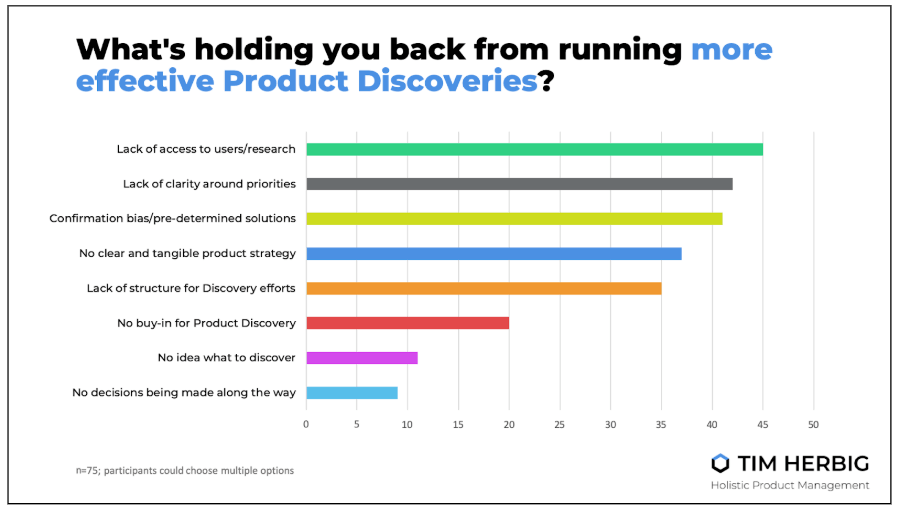
The main hurdle? The fight against confirmation bias and predetermined solutions (among other things).
Product discovery can’t just be structured in the same foreseeable way as a product delivery cycle. One common manifestation of this kind of confirmation bias is seeing management, stakeholders, peers, and sometimes even developers quickly getting caught up in specific solutions. Whenever the conversation turns to tasks and planning, the focus immediately shifts towards tactics.
Instead, the real magic (and main challenge) of product discovery lies in working through different phases. Product discovery work is all about uncovering new user segments and understanding existing ones even better. It’s about making sense of user insights and changing user behavior through iteration and improvement.
While the execution of the above activities already poses a challenge, keeping them on track during the messy reality of product discovery is an even bigger one.
Now, what if there were a way to organize the elements mentioned above in relation to each other? What if this connection would not only help you to get stakeholders and management on board but would also help you sideline pre-determined feature ideas? What if it also encouraged you to document your product discovery insights and structure your overall product discovery efforts?
Thankfully, there is such a thing. And it’s called impact mapping.
A Brief Overview of Impact Mapping
Impact mapping, in its original form, was created by Gojko Adzic, who coined the term in his book in 2012. The goal was to support the strategic alignment of business sponsors, stakeholders, and delivery teams. However, in this article, I want to share a different interpretation of impact mapping, tailored to the challenges and needs for product discovery efforts.
The general idea of an impact map is to divide the stages of product discovery opportunity into their components. In my adapted version, this separation results in a five-level map.
Every level of the map aims to clarify one specific question that you then try to answer through the application of product discovery techniques. The beauty of the impact map lies in two aspects:
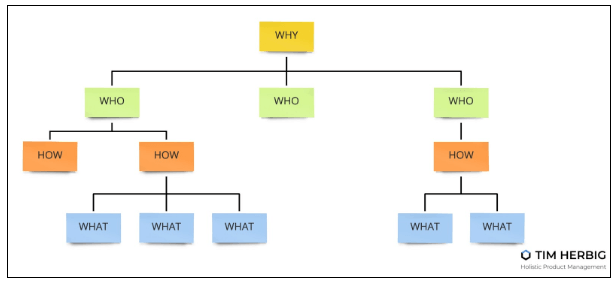
- Its visual representation makes it easier to document your results, form relationships between insights, spot and avoid dead ends, and uncover new paths forward.
- Its hierarchical order keeps you from discussing solutions and feature ideas too quickly. Only when you have clarity on one level can you move to the next one. Think of it as unlocking a new level in a video game.
With these general traits in mind, let’s look at the individual levels of the impact map version I use and recommend in the context of product discovery.
Level 1: WHY
This level is about clarifying the context and need around a product discovery initiative. It helps the team connect their actions to the company’s success.
That’s why I like to refer to the goal listed here as an impact. An impact can represent any change in a business metric (revenue, churn, conversion rate, user satisfaction, etc). The goal articulated at this level should represent the desired business impact to be addressed, not a predetermined solution.
This metric should help the team frame their mission in business terms. After all, you don‘t run product discovery just for the sake of doing it.
Here are some examples of impacts which could go into this level:
- Generate $100,000 from new enterprise customers within the next 12 months
- Improve customer effort score by 1.5 points by the end of Q4
- Increase the number of qualified bookings for tattoo studios by 20% by Q4
Don’t let this number or timeline become too rigid. However, these impact statements should help the team check whether their actions match the overall goal. For example, a simple button color change might be ready in time but won’t give you the uplift you’re looking for. On the flipside, reinventing how online checkouts work might really increase conversions, but would take too long.
Ideally, you‘ll create clarity on this level during the early phases of product discovery. At this stage, alignment, shared understanding, and collaboration are critical.
Level 2: WHO
People listed here can include apparent choices like existing and new users. However, the real power of the impact map unfolds once you start to map out “off-stage” actors. These are the users who interact with your product indirectly.
Let’s say you’re building tattoo studio management software as a B2B SaaS solution. Your product discovery efforts focus on appointment scheduling. Now, the straightforward users to list on an impact map would be the studio owners and maybe their receptionists. However, your research uncovers the importance of the studio’s clientele. They don’t purchase your software but will use the scheduling interface. Therefore, they’ll contribute to the (potential) impact of selling to more studios with their satisfaction and success in booking an appointment.
You might then uncover true off-stage actors by talking to some of the studio clients. Maybe some of the interviews reveal a significant share of non-adults wanting to book appointments. Now you add the parents of these kids to the WHO level of your impact map. Perhaps their needs and expectations could play a significant role in getting more teenagers to sign up for a tattoo appointment.

This level of the impact map is meant to get filled gradually as you move through different research activities in your product discovery. Most companies can name one or two players on this level pretty quickly. However, the full picture requires serious work, making it a great companion for continuous survey and interview insights.
Level 3: HOW
The third level of an impact map is often the toughest to work through. This is where you decide HOW you want and need to change the behavior of the identified users to drive the impact.
This level is where my interpretation differs from Gojko Adzic’s. At this stage, I like to stick to Josh Seiden’s definition of an outcome. He defines an outcome as “a change in human behavior that drives business results.” This perfectly matches the items on this level of the impact map.
A word of caution: as we move further down the impact map, we’re nearing the entrance to the solution space — the act of finally talking about all these beautiful feature ideas. However, as an impact map will always point out, we’re probably pursuing feature ideas for the sake of doing so, if we cannot connect them to an overarching business impact. Outcomes are the critical puzzle piece connecting these two elements.
If you remember anything about this level of the impact map, it should be that outcomes are not product features. So, avoid listing specific solutions. Try to be explicit about how you want to change user behavior. Should people be able to complete an activity faster or slower? Should it be easier? More safe or convenient?
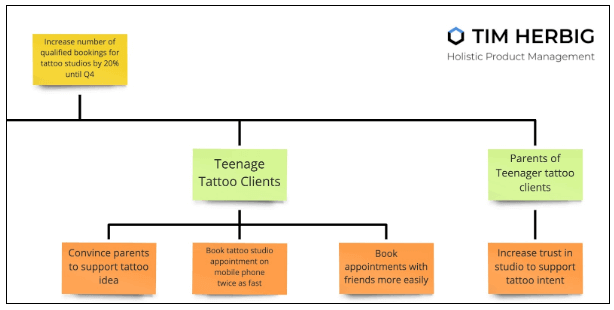
Here are some examples of impacts which could go into this level:
- Collect and check parental declarations of consent more easily
- Respond to customer requests faster using Slack
- Create a real estate listing from your smartphone
Level 4: WHAT
While many people get most excited about this level of the impact map, it’s actually one of the least important. This stage aims to articulate WHAT potential solutions the team could pursue to cause the desired changes in behavior. It’s the moment that many have been waiting for since the discovery process started. It’s time to enter the solution space.
To fill this level of the impact map, engage the temporary and permanent discovery team members in a range of ideation sessions. Since you’ve consistently followed the impact mapping process to this point, you can now frame these sessions in a tangible way.
To foster effective ideation at this stage, focus on two things:
- Bringing everyone up to speed on your existing insights to level the playing field for participants. Be clear about the overall impact you want to achieve and share what you have learned so far through the WHO and HOW levels.
- Prioritizing one to three outcomes from the HOW level as the focus for the ideation session.
The result of this stage should be a broad set of ideas you can place on your impact map. Don’t worry about having too many ideas at this stage — we’ll get to that. And don’t get into too much detail either.
Level 5: WHETHER
The elements on the WHAT level shouldn’t be taken for granted. Not everything which has been brainstormed will be implemented. In fact, I recommend wrapping up the ideation sessions with this disclaimer, to set expectations for the remainder of the discovery process.
This level of the impact map helps you answer WHETHER you should pursue an idea. It’s time to validate those shiny new ideas through experimentation (not gut feeling).
I expanded the original concept of the impact map to help teams approach the validation phase of product discovery in a structured manner. To get started, align the team to a specific priority of your generated ideas. Pretty much every lightweight prioritization framework is suited to help you do that. Keep in mind that this intermediate prioritization doesn’t answer which ideas will ultimately be built, but instead which ones you want to validate first.
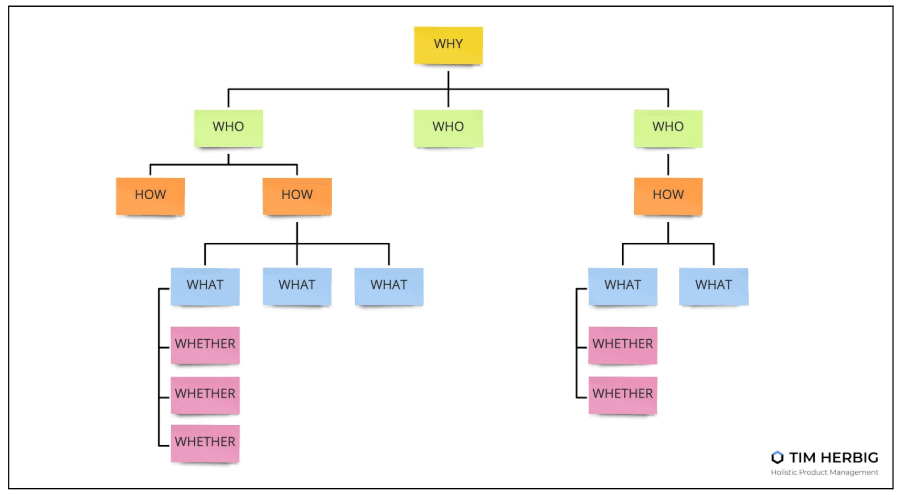
You can customize this level of the impact map depending on your experiment setups. Make sure to be explicit about the assumptions you’re looking to validate and document your results. The insights from the experiments should then result in a filtered selection of the WHAT level items you want to continue to pursue.
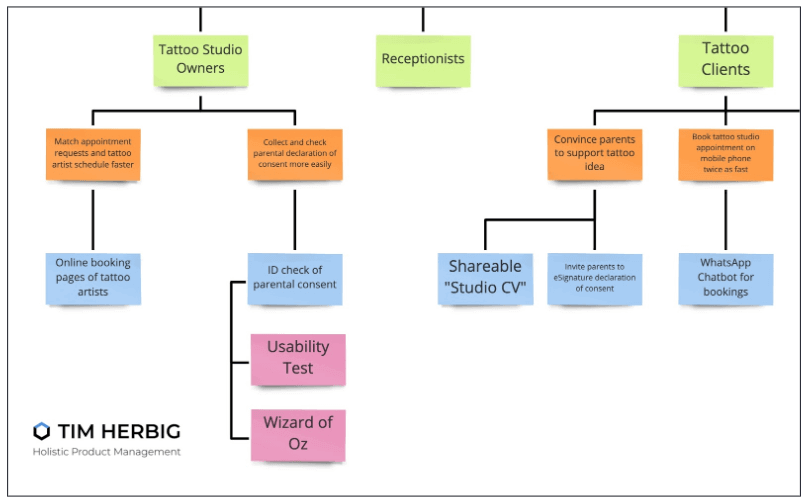
Connecting the Dots
The litmus test for checking an idea against the content of an impact map is to see whether you can form a sentence (which makes sense) across all levels, explaining why you want to pursue a feature idea.
This way of thinking forces you to be clear about how this idea came to life and why experiment results support it.
You can also use your impact map to check new ideas against the pieces of evidence you have in place. Does this idea help to create a change in behavior we have prioritized? Not sure? Let’s prioritize validation around it and place it as a bet on the WHAT level. Did a new user segment emerge from continuous research activities? Great, time to expand the map and discuss this discovery as a potential priority for the team.
Keep the map visible to remind yourself and your team of what you have accomplished, and as an evidence locker to revisit and expand over time. Because after all, that’s what product discovery is about — Gathering evidence to support our decision-making processes.
For more information on recognizing and avoiding confirmation bias during product discovery, register for the upcoming webinar.

